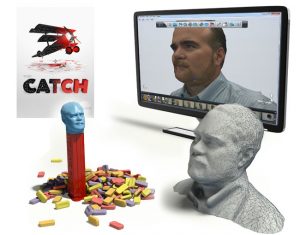123D Catch – Ipad app
Subject: Digital Technologies
Year level: F-2
Strand: Digital Technologies – Knowledge and understanding
Sub-strand: Digital Systems
Content description: Recognise and explore digital systems (hardware and software components) for a purpose (ACTDIK001).
Elaborations:
- Playing with and using different digital systems for transferring and capturing data.
- Exploring and using digital systems for downloading and storing information.
(As per Western Australian Curriculum – SCSA)
What is 123D Catch?
The 123D Catch app turns your mobile phone or tablet into a 3D scanner. By taking up to 40 photos of an object, this powerful software can produce a 3D digital model of the item to view it from all angles by rotating it on your screen or recreate a physical model (providing you have a 3D printer handy). It features sophisticated designing tools for remodelling your 3D digital object as well as interactive capabilities for sharing or uploading. 123D Catch is free to download and very user-friendly.
Link to the resource:
Cross-curriculum priorities and general capabilities:
- Literacy
- Critical and creative thinking
- Information and communication technology
Links to other learning areas:
- Mathematics
- English
- The Arts
Using this resource in the classroom:
This app allows anyone to digitalise an object into 3D format. And utilising the app’s tools to rotate the 3D digital object on a technology platform screen enhances the ability to visualise and examine the object in greater detail. In a classroom setting, students will find this software helpful in learning about 3D shapes and the relationship between shapes in many everyday objects. Learning can be further extended to geometry and design with the use of this app and its functions. By creating design projects for students with this app, they are challenged to problem solve and find solutions using their critical and creative thinking. It also provides an interactive component as students can share and comment on each other’s 3D images.
123D Catch supports many critical and creative skills that are valuable to children’s learning and development, such as:
- Strategic use of digital media and technology
- Reasoning and decision making
- Designing and creating
How to use this resource:
- Download the app by visiting the website (http://www.123dapp.com/catch).
- Launch the app and follow the tutorial walk-through that covers all the features and how to use them.
- Refer to the “Learn how to use 123D Catch” webpage (http://www.123dapp.com/howto/catch) and other helpful videos available on the website.
- Take 20 to 40 photos of a chosen object (e.g. a teddy bear) from as many different angles as possible.
- Review all your photos with the option to delete and retake more photos before uploading all the photos to a cloud-based 3D solving service.
- The cloud software examines all the photos and extrapolates every common point and angle of the object shot then stitches them together to generate a textured 3D digital model.
- The 3D digital model can simply be viewed and shared or used to produce a physical model using a 3D printer.
Requirements:
- Wifi
- Phone or tablet
Link to a video tutorial for this technology:
Link to more tutorials and helpful tips:
- http://www.123dapp.com/howto/catch



